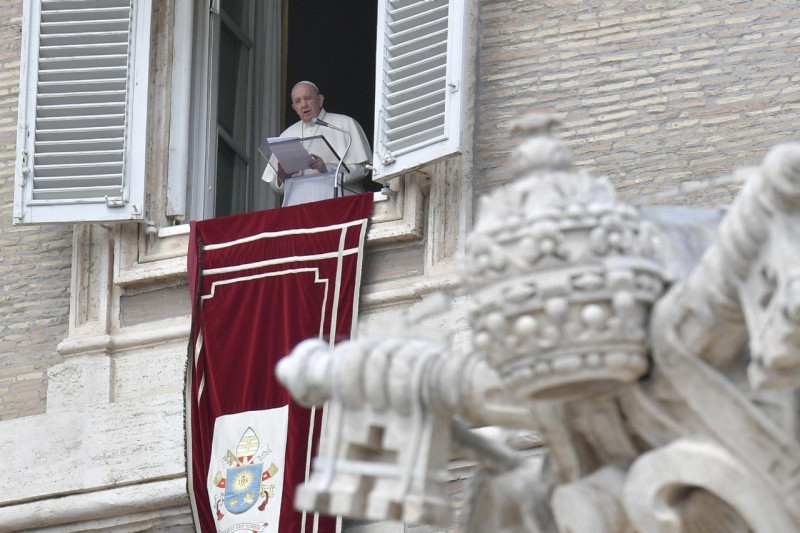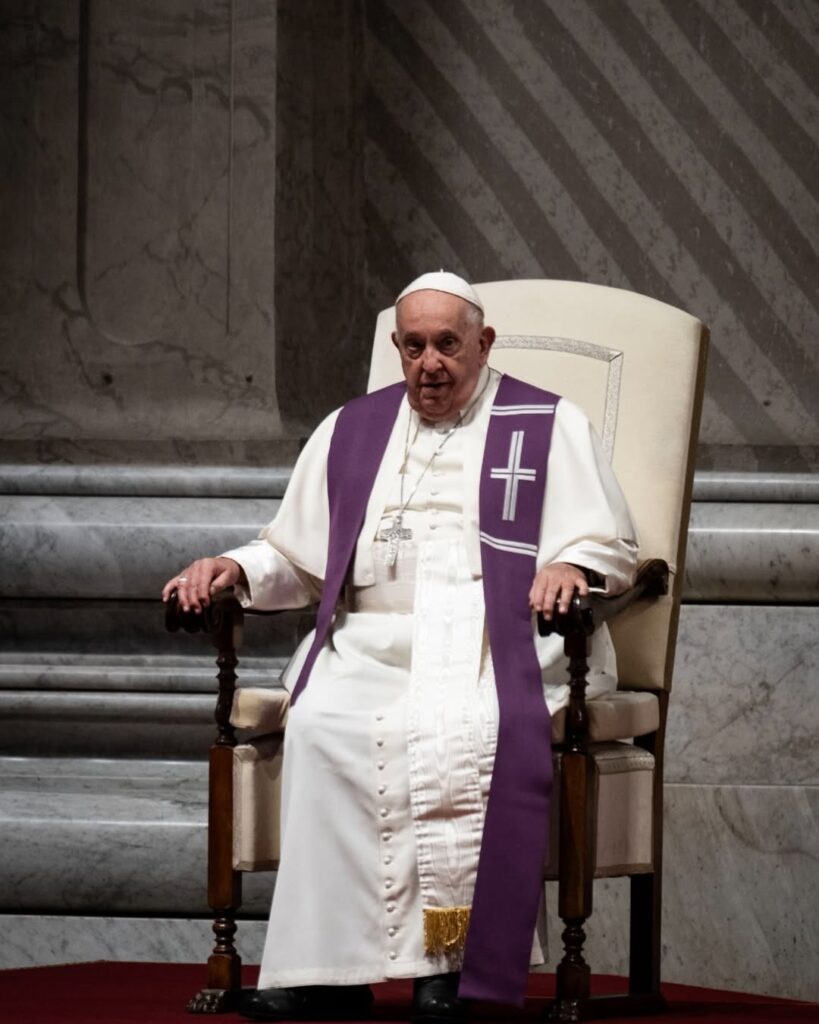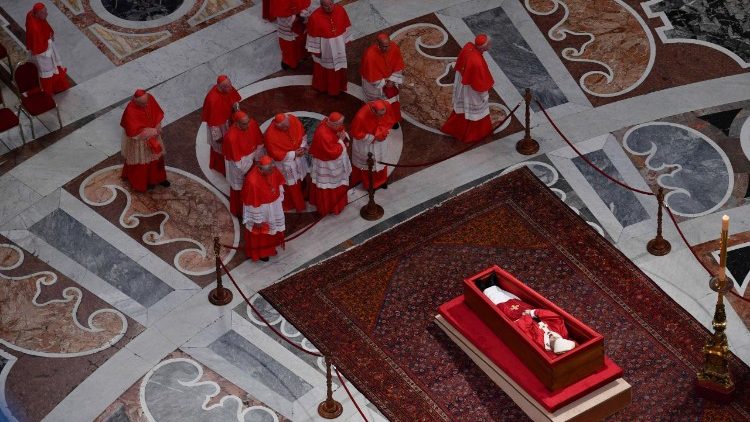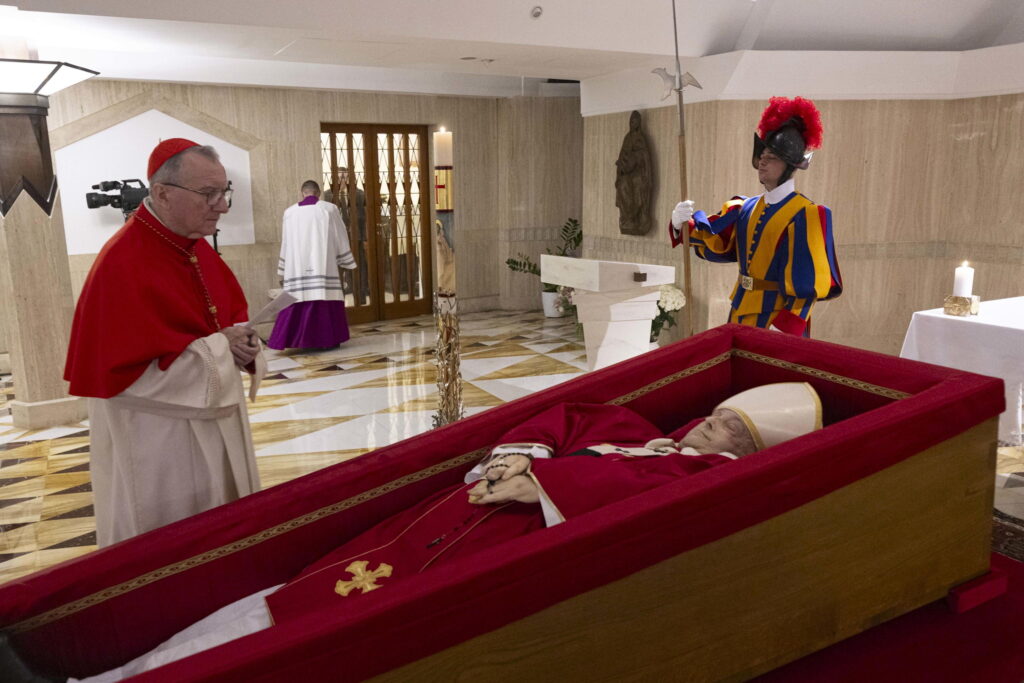Look, Touch, Eat: Pope at Regina Caeli
Holy Father's First 'Live' Appearance in St. Peter's Square in a Month due to Pandemic Restrictions

“To look, to touch, and to eat” are three aspects that bring joy in a true encounter with Jesus Christ.
This was the message of Pope Francis in his message before reciting the Regina Caeli with the faithful gathered in St. Peter’s Square. It was the Holy Father’s first “live” appearance in the square in a month due to pandemic restrictions.
In his message, he cited the day’s Gospel from the 24th chapter of Luke, where the risen Lord meets with the disciples and gives proof that he truly is alive.
“Three very concrete verbs characterize this Gospel passage,” the Pope said. “In a certain sense, they reflect our individual and community life: to look, to touch and to eat. Three actions that can give joy from a true encounter with the living Jesus.”
The Holy Father recounted the three things Jesus did to give joy to the disciples by proving his presence:
- He showed them his hands and feet, bearing the wounds of the crucifixion.
- He allowed them to touch the wounds.
- He broke bread with them.
“Brothers and sisters, this Gospel passage tells us that Jesus is not a ‘ghost’, but a living Person; that when Jesus draws near to us he fills us with joy, to the point of disbelief, and he leaves us bewildered, with that astonishment that only God’s presence gives because Jesus is a living Person,” Francis concluded.
Following is the Holy Father’s full message, provided by the Vatican:
Dear Brothers and Sisters, Buongiorno!
On this Third Sunday of Easter, we return to Jerusalem, in the Cenacle, as guided by the two disciples of Emmaus, who had listened with great emotion to Jesus’ words along the way and then had recognized him “in the breaking of the bread” (Lk 24:35). Now, in the Cenacle, the Risen Christ presents himself in the midst of the group of disciples and greets: “Peace to you!” (v. 36). But they are frightened and believe “that they saw a spirit” (v. 37), as the Gospel says. Then Jesus shows them the wounds in his body and says: “See my hands and my feet” – the wounds – “that it is I myself; handle me” (v. 39). And to convince them, he asks for food and eats it before their astonished eyes (cf. vv. 41-42).
There is a detail here, in this description. The Gospel says that the Apostles “they still disbelieved for joy”. The joy they had was such that they could not believe that this was true. And a second detail: they were bewildered, astonished; astonished because the encounter with God always leads you to astonishment: it goes beyond enthusiasm, beyond joy; it is another experience. And they were joyful, but a joy that made them think: no, this cannot be true!… It is the astonishment of God’s presence. Do not forget this frame of mind, which is so beautiful.
Three very concrete verbs characterize this Gospel passage. In a certain sense, they reflect our individual and community life: to look, to touch and to eat. Three actions that can give joy from a true encounter with the living Jesus.
To look. “See my hands and my feet”, Jesus says. To look is not only to see, it is more; it also involves intention, will. For this reason, it is one of the verbs of love. A mother and father look at their child; lovers gaze at each other; a good doctor looks at the patient carefully…. Looking is a first step against indifference, against the temptation to look the other way before the difficulties and sufferings of others. To look. Do I see or look at Jesus?
The second verb is to touch. By inviting the disciples to touch him, to verify that he is not a ghost – touch me! – Jesus indicates to them and to us that the relationship with Him and with our brothers and sisters cannot remain “at a distance”. Christianity does not exist at a distance; Christianity does not exist only at the level of looking. Love requires looking and it also requires closeness; it requires contact, the sharing of life. The Good Samaritan did not limit himself to looking at that man whom he found half dead along the road: he stopped, he bent down, he treated his wounds, he touched him, he loaded him on his mount and took him to the inn. And it is the same with Jesus himself: loving him means entering into a communion of life, a communion with Him.
And thus, we come to the third verb, to eat, which clearly expresses our humanity in its most natural poverty, that is, our need to nourish ourselves in order to live. But eating, when we do so together, among family or friends, also becomes an expression of love, an expression of communion, of celebration…. How often the Gospels present Jesus to us who experiences this convivial dimension! Even as the Risen One, with his disciples. To the point that the Eucharistic Banquet has become the emblematic sign of the Christian community. Eating together the Body of Christ: this is the core of Christian life.
Brothers and sisters, this Gospel passage tells us that Jesus is not a “ghost”, but a living Person; that when Jesus draws near to us he fills us with joy, to the point of disbelief, and he leaves us bewildered, with that astonishment that only God’s presence gives, because Jesus is a living Person.
Being Christian is not first of all a doctrine or a moral ideal; it is a living relationship with Him, with the Risen Lord: we look at him, we touch him, we are nourished by Him and, transformed by his Love, we look at, touch and nourish others as brothers and sisters. May the Virgin Mary help us to live this experience of grace.
After the Regina Caeli:
Dear brothers and sisters!
Yesterday in the Abbey of Casamari, Cardon and five companion martyrs, Cistercian monks of that Abbey, were proclaimed Blessed. In 1799, when French soldiers withdrawing from Naples sacked churches and monasteries, these meek disciples of Christ resisted with heroic courage, unto death, to defend the Eucharist from desecration. May their example spur us to a greater commitment of fidelity to God, even capable of transforming society and making it more just and fraternal. A round of applause for the new Blesseds!
And this is something sad. I am following with deep concern the events in several areas of eastern Ukraine, where in recent months violations of the cease-fire have multiplied, and I observe with great apprehension the increase of military activities. Please, I firmly hope that the increase of tensions may be avoided and, on the contrary, gestures may be made that are capable of promoting mutual trust and fostering reconciliation and peace, so necessary and so desired. May we also keep at heart the grave humanitarian situation being experienced by that population, to whom I express my closeness and for whom I invite you to pray. Ave Maria….
Today in Italy we are celebrating the Day for the Catholic University of the Sacred Heart, which for one hundred years has offered a valuable service for the formation of the new generations. May it continue to carry out its educational mission to help young people to be protagonists of a future rich in hope. I offer my heartfelt blessing to the staff, professors, and students of the Catholic University.
And now I offer a warm greeting to all of you, people of Rome and pilgrims…, Brazilians, Poles, Spanish people…, and I see another flag there…. Thanks be to God we can find ourselves again in this Square for the Sunday and holiday appointment. I’ll tell you something: I miss the Square when I have to recite the Angelus in the library. I am happy, thanks be to God! And thank you for your presence…. To the young people of the Immacolata, who are good…. And to everyone, I wish a happy Sunday. Please do not forget to pray for me. Enjoy your lunch. Arrivederci!
© Libreria Editrice Vatican
Related

You Didn’t Give Up
Exaudi Staff
23 April, 2025
2 min

“We have experienced a brilliant pontificate that has touched the hearts of believers and non-believers alike”
Exaudi Staff
23 April, 2025
6 min

Funeral of Pope Francisco on April 26th in the Plaza de San Pedro
Exaudi Staff
23 April, 2025
3 min

“You give us hope and remind us that God does not forget us” importa
Exaudi Staff
22 April, 2025
5 min
 (EN)
(EN)
 (ES)
(ES)
 (IT)
(IT)

